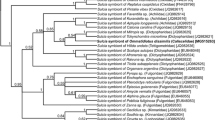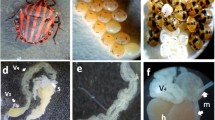Abstract
A number of phytophagous stinkbugs are associated with specific bacterial symbionts in their alimentary tracts. The sloe bug Dolycoris baccarum (Linnaeus), a notorious pest of diverse crops, possesses a number of sac-like tissues, called crypts, in a posterior section of the midgut, wherein a specific bacterial symbiont colonizes. Here we characterized the symbiotic bacterium of D. baccarum by histological analysis, molecular phylogeny, and diagnostic PCR with a specific primer set. The cloning and sequencing analyses of bacterial 16S rRNA genes and fluorescent in situ hybridization demonstrated that the sloe bug is associated with a single species of Gammaproteobacteria in the midgut crypts. Molecular phylogenetic analysis strongly suggested that the symbiont should be placed in the genus Pantoea of the Enterobacteriaceae. Diagnostic PCR and egg surface sterilization with formalin indicated the stinkbug vertically transmits the Pantoea symbiont via egg-smearing. The sterilization-produced aposymbiotic nymphs showed high mortality and no insects reached adulthood. In addition, the Pantoea symbiont was uncultivable outside the insect host, indicating an obligate and intimate host-symbiont association.



Similar content being viewed by others
References
Abe Y, Mishiro K, Takanashi M (1995) Symbiont of brown-winged green bug, Plautia stali Scott. Jpn J Appl Entomol Zool 39:109–115
Amann RI, Binder BJ, Olson RJ, Chisholm SW, Devereux R, Stahl DA (1990) Combination of 16S rRNA-targeted oligonucleotide probes with flow cytometry for analyzing mixed microbial populations. Appl Environ Microbiol 56:1919–1925
Bistolas KS, Sakamoto RI, Fernandes JA, Goffredi SK (2014) Symbiont polyphyly, co-evolution, and necessity in pentatomid stinkbugs from Costa Rica. Front Microbiol 5:349
Buchner P (1965) Endosymbiosis of animals with plant microorganisms. Interscience, New York
Douglas AE (1998) Nutritional interactions in insect-microbial symbioses: aphids and their symbiotic bacteria Buchnera. Annu Rev Entomol 43:17–37
Duron O, Noël V (2016) A wide diversity of Pantoea lineages are engaged in mutualistic symbiosis and cospeciation processes with stinkbugs. Environ Microbiol Rep (in press)
Fukatsu T, Hosokawa T (2002) Capsule-transmitted gut symbiotic bacterium of the Japanese common plataspid stinkbug, Megacopta punctatissima. Appl Environ Microbiol 68:389–396
Fukatsu T, Nikoh N (1998) Two intracellular symbiotic bacteria from the mulberry psyllid Anomoneura mori (Insecta, Homoptera). Appl Environ Microbiol 64:3599–3606
Glasgow H (1914) The gastric caeca and the caecal bacteria of the Heteroptera. Biol Bull 3:101–171
Hayashi T, Hosokawa T, Meng XY, Koga R, Fukatsu T (2015) Female-specific specialization of a posterior end region of the midgut symbiotic organ in Plautia splendens and allied stinkbugs. Appl Environ Microbiol 81:2603–2611
Hosokawa T, Kikuchi Y, Nikoh N, Shimada M, Fukatsu T (2006) Strict host-symbiont co-speciation and reductive genome evolution in insect gut bacteria. PLoS Biol 4:e337
Hosokawa T, Hironaka M, Mukai H, Inadomi K, Suzuki N, Fukatsu T (2012) Mothers never miss the moment: a fine-tuned mechanism for vertical symbiont transmission in a subsocial insect. Anim Behav 83:293–300
Hosokawa T, Hironaka M, Inadomi K, Mukai H, Nikoh N, Fukatsu T (2013) Diverse strategies for vertical symbiont transmission among subsocial stinkbugs. PLoS One 8:e65081
Hosokawa T, Ishii Y, Nikoh N, Fujie M, Satoh N, Fukatsu T (2016) Obligate bacterial mutualists evolving from environmental bacteria in natural insect populations. Nat Microbiol 1:15011
Kaiwa N, Hosokawa T, Kikuchi Y, Nikoh N, Meng XY, Kimura N, Ito M, Fukatsu T (2010) Primary gut symbiont and secondary, Sodalis-allied symbiont of the Scutellerid stinkbug Cantao ocellatus. Appl Environ Microbiol 76:3486–3494
Kaiwa N, Hosokawa T, Nikoh N, Tanahashi M, Moriyama M, Meng XY, Maeda T, Yamaguchi K, Shigenobu S, Ito M, Fukatsu T (2014) Symbiont-supplemented maternal investment underpinning host’s ecological adaptation. Curr Biol 24:2465–2470
Katoh K, Standley DM (2013) MAFFT multiple sequence alignment software version 7: improvements in performance and usability. Mol Biol Evol 30:772–780
Kikuchi Y (2009) Endosymbiotic bacteria in insects: their diversity and culturability. Microbes Environ 24:195–204
Kikuchi Y, Fukatsu T (2014) Live imaging of symbiosis: spatiotemporal infection dynamics of a GFP-labelled Burkholderia symbiont in the bean bug Riptortus pedestris. Mol Ecol 23:1445–1456
Kikuchi Y, Hosokawa T, Fukatsu T (2007) Insect-microbe mutualism without vertical transmission: a stinkbug acquires beneficial gut symbiont from environment every generation. Appl Environ Microbiol 73:4308–4316
Kikuchi Y, Hosokawa T, Nikoh N, Meng XY, Kamagata Y, Fukatsu T (2009) Host-symbiont co-speciation and reductive genome evolution in gut symbiotic bacteria of acanthosomatid stinkbugs. BMC Biol 7:2
Kikuchi Y, Hosokawa T, Fukatsu T (2011) An ancient but promiscuous host-symbiont association between Burkholderia gut symbionts and their heteropteran hosts. ISME J 5:446–460
Kikuchi Y, Hosokawa T, Nikoh N, Fukatsu T (2012) Gut symbiotic bacteria in the cabbage bugs Eurydema rugosa and Eurydema dominulus (Heteroptera: Pentatomidae). Appl Entomol Zool 47:1–8
Matsuura Y, Kikuchi Y, Meng XY, Koga R, Fukatsu T (2012) Novel clade of alphaproteobacterial endosymbionts associated with stinkbugs and other arthropods. Appl Environ Microbiol 78:4149–4156
Mccutcheon JP, Moran NA (2012) Extreme genome reduction in symbiotic bacteria. Nat Rev Microbiol 10:13–26
Nikoh N, Hosokawa T, Oshima K, Hattori M, Fukatsu T (2011) Reductive evolution of bacterial genome in insect gut environment. Genome Biol Evol 3:702–714
Panizzi AR (1997) Wild hosts of pentatomids: ecological significance and role in their pest status on crops. Ann Rev Entomol 42:99–122
Prado SS, Almeida RPP (2009) Role of symbiotic gut bacteria in the development of Acrosternum hilare and Murgantia histrionica. Entomol Exp Appl 132:21–29
Prado SS, Daniel R, Almeida RPP (2006) Vertical transmission of a pentatomid caeca-associated symbiont. Ann Entomol Soc Am 99:577–585
Prado SS, Hung KY, Daugherty MP, Almeida RPP (2010) Indirect effects of temperature on stink bug fitness, via maintenance of gut-associated symbionts. Appl Environ Microbiol 76:1261–1266
R Development Core Team (2010) R: a language and environment for statistical computing. R Foundation for Statistical Computing, Vienna, Austria. ISBN 3-900051-07-0. http://www.R-project.org
Rider DA (2015) Pentatomoidea home page. North Dakota State University, North Dakota. http://www.ndsu.nodak.edu/ndsu/rider/Pentatomoidea/
Robinson-Rechavi M, Huchon D (2000) RRTree: relative-rate tests between groups of sequences on a phylogenetic tree. Bioinformatics 16:296–297
Salem H, Kreutzer E, Sudakaran S, Kaltenpoth M (2013) Actinobacteria as essential symbionts in firebugs and cotton stainers (Hemiptera, Pyrrhocoridae). Environ Microbiol 15:1956–1968
Salem H, Bauer E, Strauss AS, Vogel H, Marz M, Kaltenpoth M (2014) Vitamin supplementation by gut symbionts ensures metabolic homeostasis in an insect host. Proc Biol Sci 281:20141838
Sasaki T, Ishikawa H (1995) Production of essential amino acids from glutamate by mycetocyte symbionts of the pea aphid, Acyrthosiphon pisum. J Insect Physiol 41:41–46
Schaefer CW, Panizzi AR (2000) Heteroptera of economic importance. CRC Press, Boca Raton, FL
Tada A, Kikuchi Y, Hosokawa T, Musolin DL, Fujisaki K, Fukatsu T (2011) Obligate association with gut bacterial symbiont in Japanese populations of the southern green stinkbug Nezara viridula (Heteroptera: Pentatomidae). Appl Entomol Zool 6:483–488
Tamura K, Dudley J, Nei M, Kumar S (2007) MEGA4: molecular evolutionary genetics analysis (MEGA) software version 4.0. Mol Biol Evol 24:1596–1599
Taylor CM, Coffey PL, Delay BD, Dively GP (2014) The importance of gut symbionts in the development of the brown marmorated stink bug, Halyomorpha halys (Stal). PLoS One 9:e90312
Tomokuni M, Yasunaga T, Takai M, Yamashita I, Kawamura M, Kawasawa T (1993) Terrestrial heteropterans: A field guide to Japanese bugs. Zenkoku noson Kyoiku Kyokai, Tokyo
Weirauch C, Schuh RT (2011) Systematics and evolution of Heteroptera: 25 years of progress. Ann Rev Entomol 56:487–510
Wernegreen JJ (2002) Genome evolution in bacterial endosymbionts of insects. Nat Rev Genet 3:850–861
Acknowledgements
We thank H. Toju, K. Takeshita, E. Hara, Y.G. Baba, S. Kudo, and M. Baba for insect samples, and N. Nakamura and M. Okamoto for technical assistance. This study was supported by the Japan Society for the Promotion of Science (JSPS), project 15H05638.
Author information
Authors and Affiliations
Corresponding author
Rights and permissions
About this article
Cite this article
Itoh, H., Matsuura, Y., Hosokawa, T. et al. Obligate gut symbiotic association in the sloe bug Dolycoris baccarum (Hemiptera: Pentatomidae). Appl Entomol Zool 52, 51–59 (2017). https://doi.org/10.1007/s13355-016-0453-0
Received:
Accepted:
Published:
Issue Date:
DOI: https://doi.org/10.1007/s13355-016-0453-0




